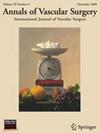敌意动脉入路腹主动脉瘤的血管内治疗:一项多中心回顾性研究。
IF 1.4
4区 医学
Q3 PERIPHERAL VASCULAR DISEASE
引用次数: 0
摘要
目的:本研究旨在记录我们使用低位内移植物进行腹主动脉瘤(AAA)血管内修复的经验,这些病例的入路动脉具有挑战性,通常被称为敌对入路动脉:回顾性收集并分析了2020年1月至2022年12月期间在三家三级医疗中心使用低位内植物进行血管内主动脉修补术(EVAR)的入路动脉狭窄或迂曲的患者数据。共有 76 名患者参与了这项研究。主要终点包括技术成功率、内漏发生率、内移植物闭塞率以及任何与设备或手术相关的主要不良事件。次要终点是评估内移植物移位、内移植物断裂、入路部位并发症和动脉瘤囊收缩:平均随访时间为 28.1±9.0 个月(14.0-54.0 个月)。其中,32 例(42.1%)患者的动脉通路狭窄(直径小于 6.0 毫米),29 例(38.2%)患者的动脉通路迂曲,15 例(19.7%)患者的动脉通路既狭窄又迂曲。73例(96.1%)患者获得了技术成功。共有 4 例(5.2%)患者因内膜移植物闭塞而接受了再次介入治疗。在随访期间,共观察到 8 例(10.5%)未进行干预的 II 型内漏,内漏在随访期间消失。分别有 25 例(32.9%)和 51 例(67.1%)观察到腹主动脉瘤骶缩小和稳定。总存活率为 98.7%。按 "狭窄动脉"、"曲折动脉 "和 "狭窄和曲折动脉 "分类的各组的围手术期和随访结果与其他组相比没有统计学意义上的显著差异:这项初步调查表明,在观察期内使用低位内植物与安全性和有效性相关。本文章由计算机程序翻译,如有差异,请以英文原文为准。
Endovascular Treatment of Abdominal Aortic Aneurysm with Hostile Artery Access: A Multi-Center Retrospective Study
Background
The objective of this study is to document our experience using low-profile endografts for the endovascular repair of abdominal aortic aneurysms (AAAs) in cases where access arteries are challenging, commonly referred to as hostile access arteries.
Methods
Data regarding patients with narrow or tortuous access arteries who underwent endovascular aortic repair (EVAR) using low-profile endografts at 3 tertiary medical centers between January 2020 and December 2022 were retrospectively collected and analyzed. A total of 76 patients were enrolled in the study. The primary endpoints included technical success, occurrence of endoleaks, endograft occlusion, and any device- or procedure-related major adverse events. Secondary endpoints were assessed for endograft migration, endograft fracture, access site complications, and aneurismal sac shrinkage.
Results
The mean follow-up duration was 28.1 ± 9.0 months (range, 14.0–54.0). Among the patients, 32 (42.1%) had narrow artery access (diameter ≤6.0 mm), 29 (38.2%) had access arteries characterized by tortuosity, and 15 (19.7%) patients presented with both narrow and tortuous access arteries. Technical success was achieved in 73 (96.1%) cases. A total of 4 (5.2%) patients received reintervention due to endograft occlusion. During follow-up, a total of 8 (10.5%) type II endoleaks were observed during follow-up without intervention, and the endoleak disappeared in the follow-up period. Abdominal aortic aneurysm-sac shrinkage and stability were observed in 25 (32.9%) and 51 (67.1%) cases, respectively. The overall survival rate was 98.7%. The perioperative and follow-up outcomes for the groups categorized by ‘Narrow arteries’, ‘Tortuous arteries’, and ‘Narrow and Tortuous arteries’ did not show statistically significant differences when compared to each other.
Conclusions
This preliminary investigation indicates that the use of low-profile endografts is associated with safety and effectiveness within the observed period.
求助全文
通过发布文献求助,成功后即可免费获取论文全文。
去求助
来源期刊
CiteScore
3.00
自引率
13.30%
发文量
603
审稿时长
50 days
期刊介绍:
Annals of Vascular Surgery, published eight times a year, invites original manuscripts reporting clinical and experimental work in vascular surgery for peer review. Articles may be submitted for the following sections of the journal:
Clinical Research (reports of clinical series, new drug or medical device trials)
Basic Science Research (new investigations, experimental work)
Case Reports (reports on a limited series of patients)
General Reviews (scholarly review of the existing literature on a relevant topic)
Developments in Endovascular and Endoscopic Surgery
Selected Techniques (technical maneuvers)
Historical Notes (interesting vignettes from the early days of vascular surgery)
Editorials/Correspondence

 求助内容:
求助内容: 应助结果提醒方式:
应助结果提醒方式:


